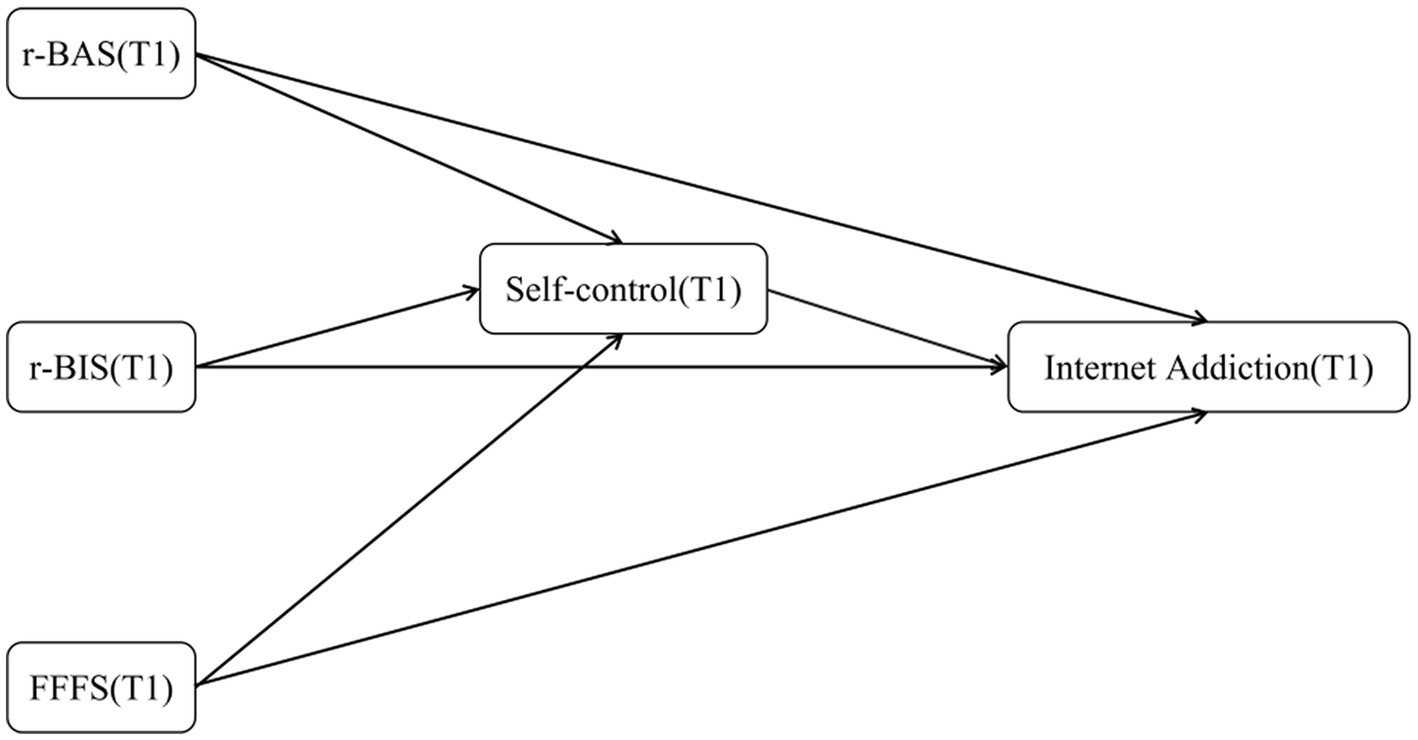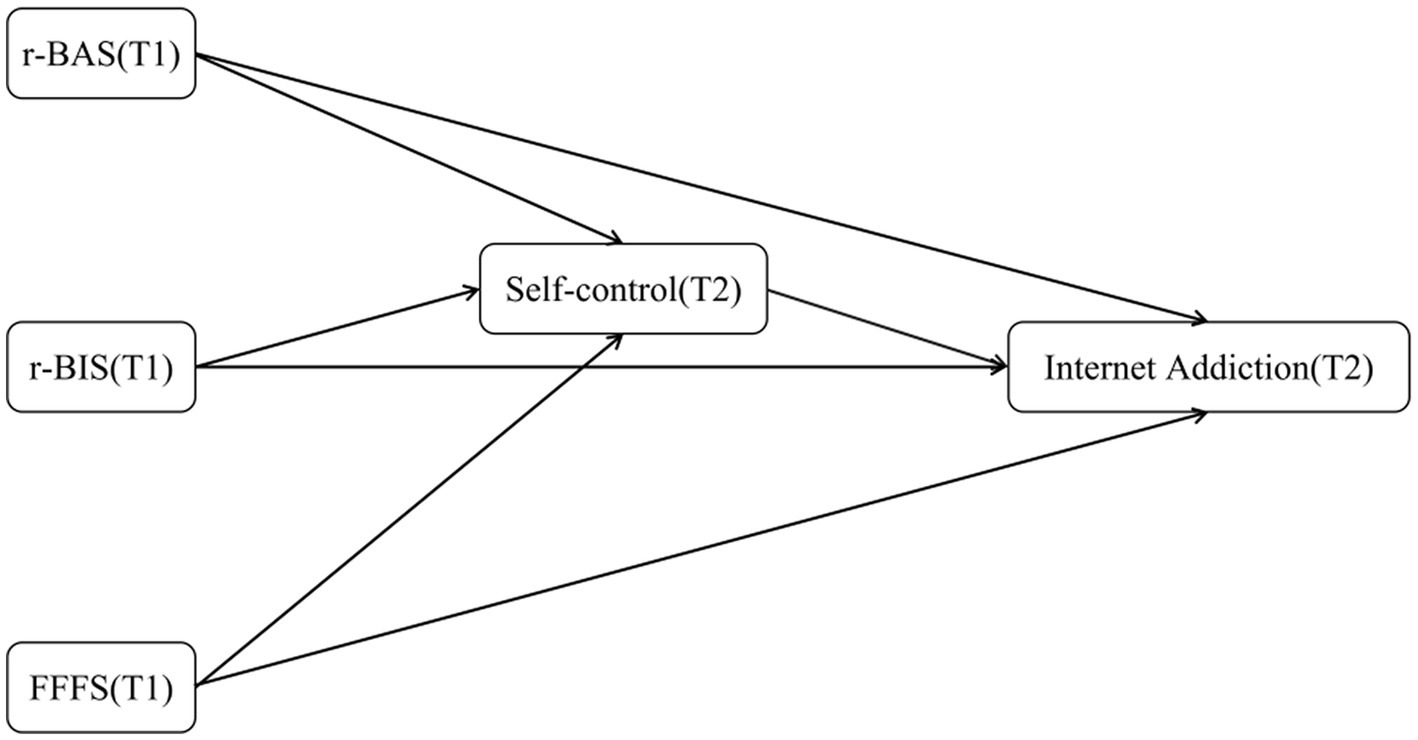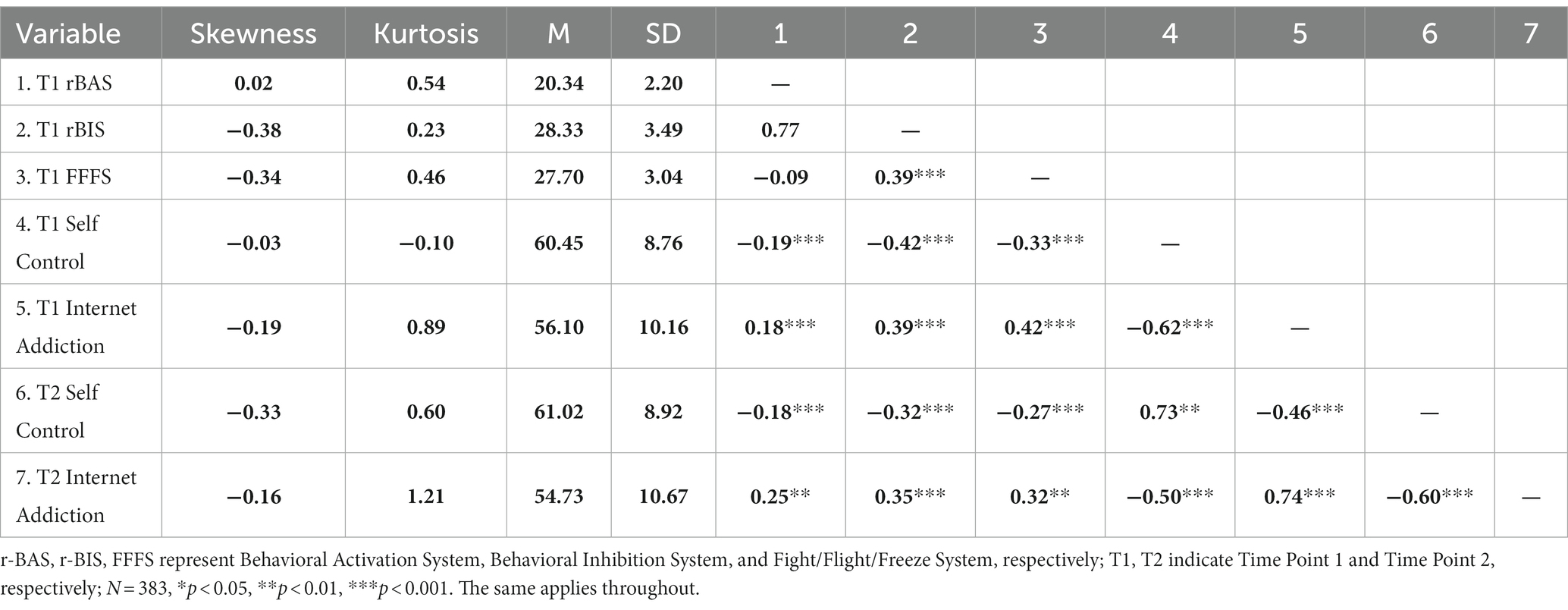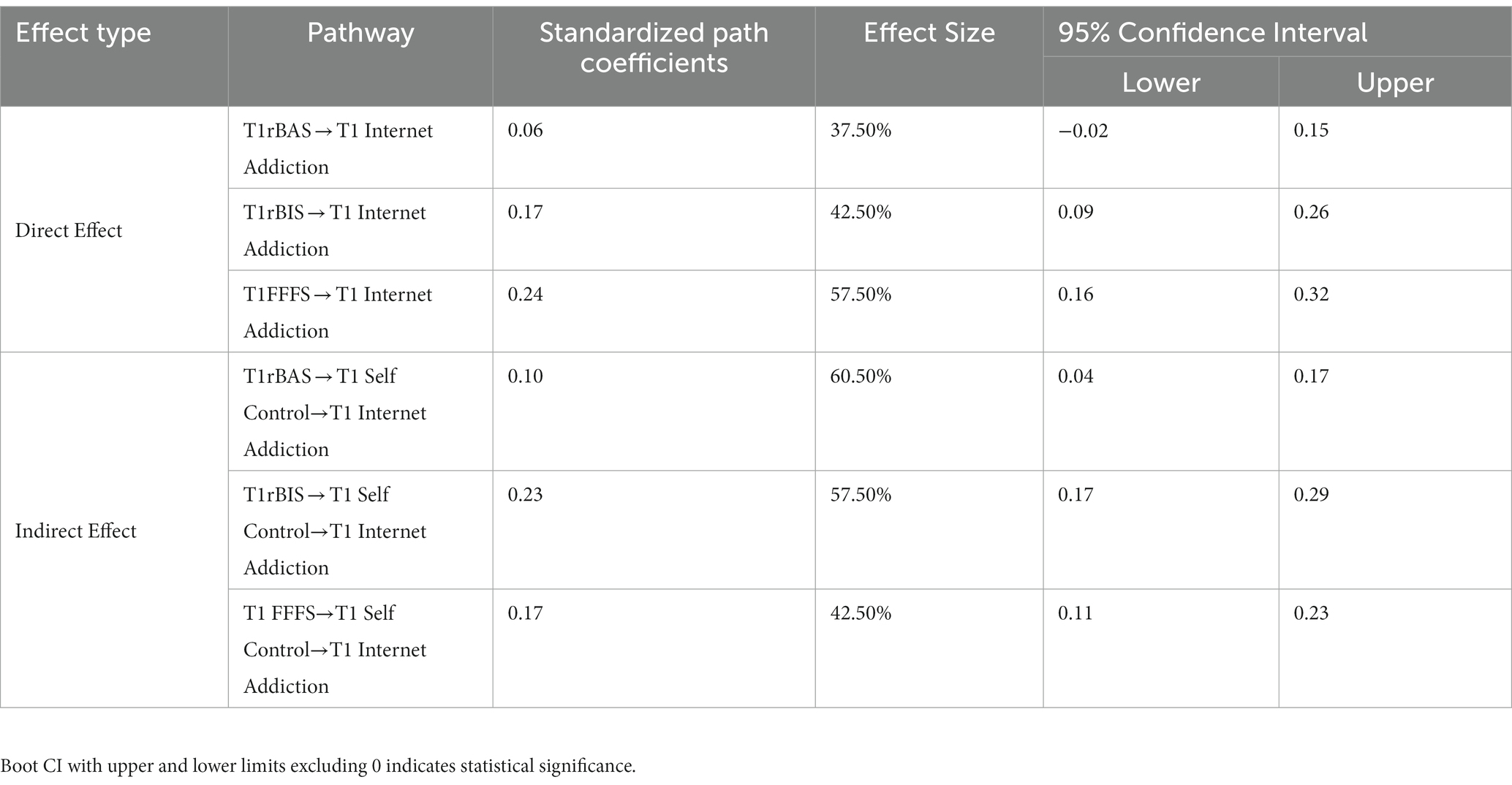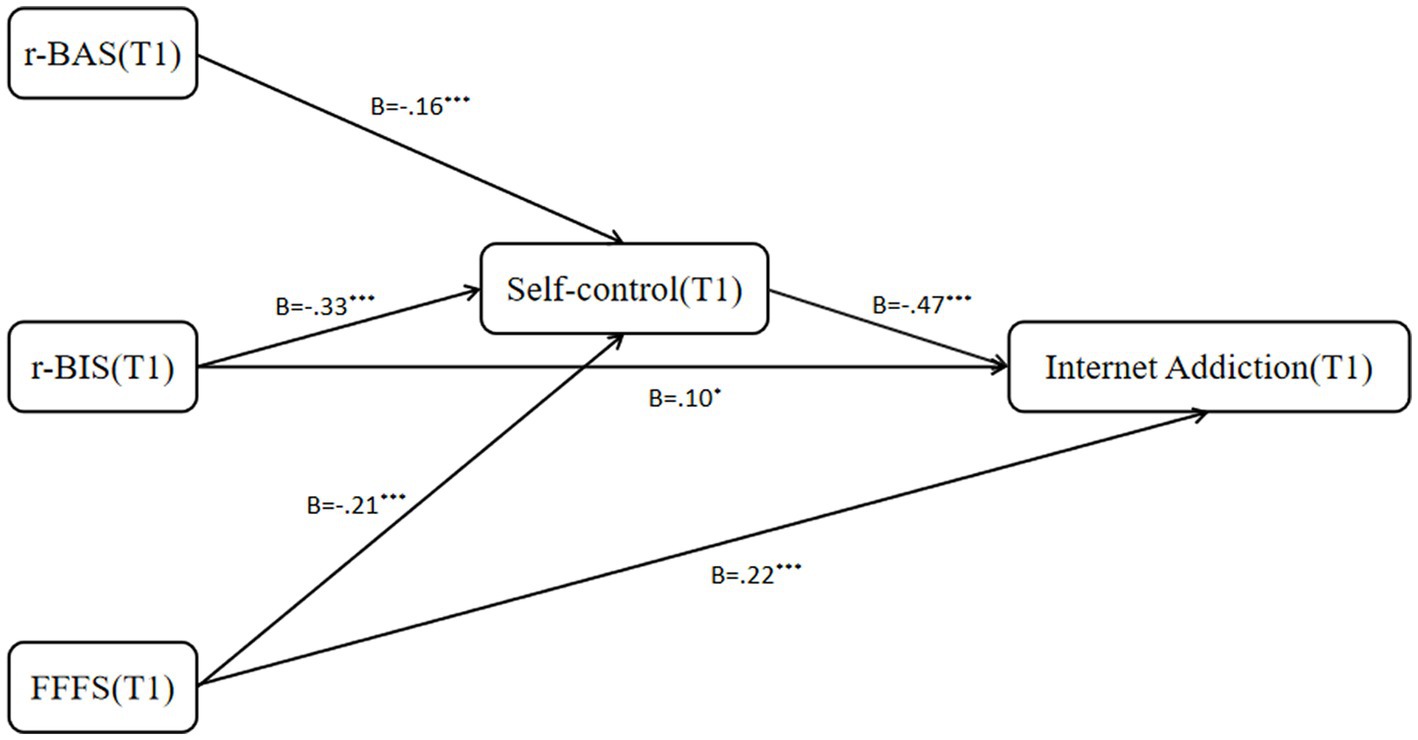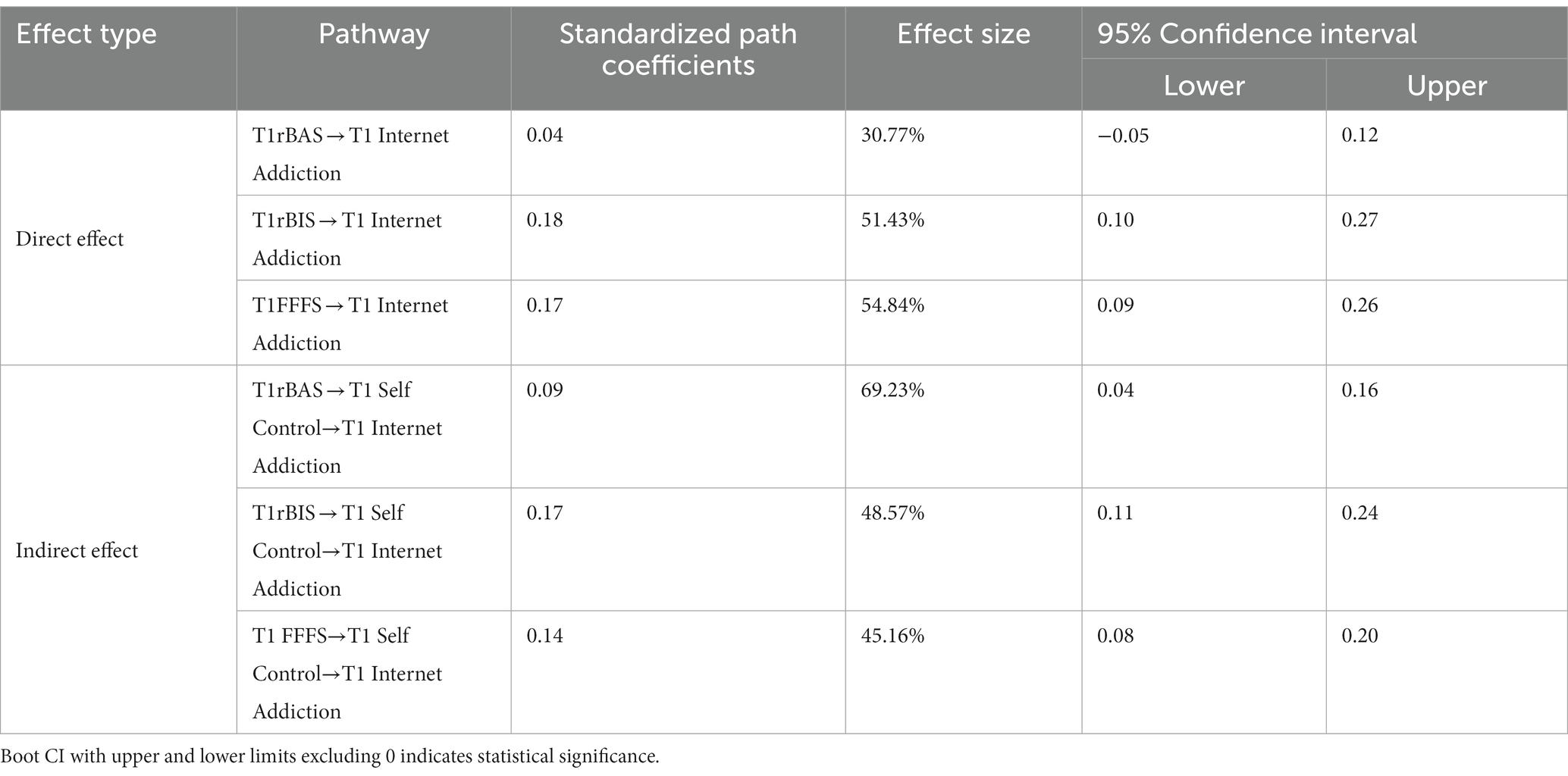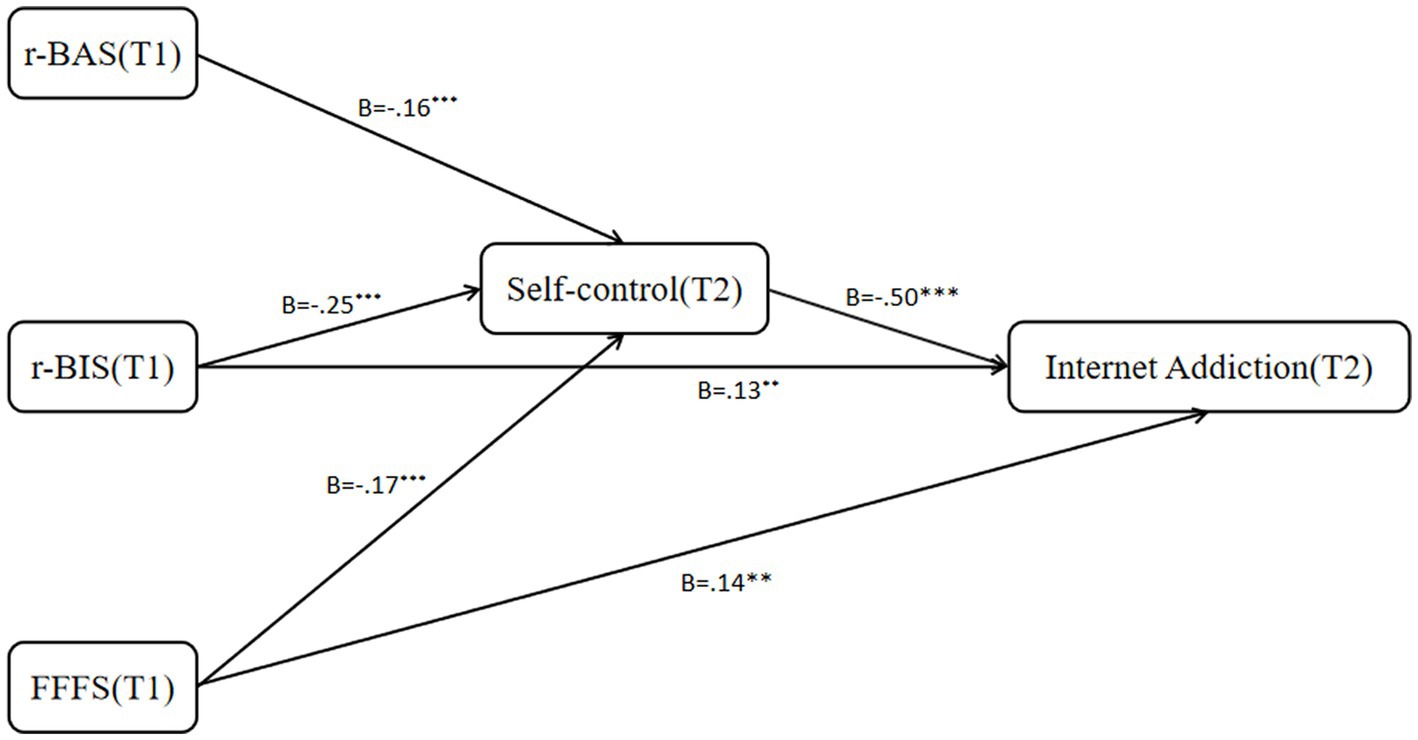- 1School of Psychology, Central China Normal University, Wuhan, China
- 2School of Nursing, Hunan University of Chinese Medicine, Changsha, China
- 3Key Laboratory of Adolescent Cyberpsychology and Behavior, Ministry of Education, Wuhan, China
- 4Xiamen Hubin High School, Xiamen, China
- 5School of Mechatronic Engineering, Hunan College of Information, Changsha, China
Introduction: As the rapid expanding of internet technology, it is necessary to pay attention to the factors that predict Internet addiction. This study aimed to investigate the longitudinal impact of reinforcement sensitivity on internet addiction among college students and the mediating role of self-control.
Methods: The study involves two follow-up assessments with a 5-month interval. 383 college students’ reinforcement sensitivity, self-control, and internet addiction were measured at two-time points.
Results: ①The revised Behavioral Approach System (r-BAS) at Time Point 1 (T1) could predict both T1 and Time Point 2 (T2) internet addiction through the complete mediation of T1 self-control. ②The revised Behavioral Inhibition System (r-BIS) at T1, along with the Fight/Flight/Freeze System (FFFS), can predict T1 and T2 internet addiction through the partial mediation of T1 self-control.
Conclusion: Reinforcement sensitivity can predict current and future internet addiction, with self-control playing a mediating role. This study provides longitudinal experimental evidence for the revised Reinforcement Sensitivity Theory (r-RST), further revealing the underlying mechanisms through which reinforcement sensitivity influences internet addiction. Additionally, it has implications for clinical intervention.
1 Introduction
College students experience increased free time and a lack of supervision, leading to a heightened demand for autonomy. Many students struggle to adapt to this change and, as a result, choose to spend their time online, making them highly susceptible to internet addiction (1, 2). Research indicates that the detection rate of internet addiction among college students is as high as 13.6% (3, 4), making it a significant factor affecting the mental and social well-being of college students (5). Therefore, paying attention to the psychological and social adaptation of individuals with internet addiction among the college student population holds crucial practical significance.
2 Reinforcement sensitivity and internet addiction
Internet addiction is a behavioral addiction disorder characterized by an inability to control the impulse to use the internet, leading to persistent immersion in online activities [Young (6)]. Internet addiction is associated with a range of emotional and behavioral disorders (7–9). The Interaction of Person-Affect-Cognition-Executive Model (I-PACE Model) posits that personality traits such as reinforcement sensitivity are among the factors influencing an individual’s susceptibility to internet addiction. Specifically, individuals with a reward-oriented and conflict-avoidant trait stemming from their reinforcement sensitivity may be more attracted to internet features such as anonymity, novelty, and immediate feedback. This attraction can lead to the development of maladaptive cognitive perceptions, wherein the online world is perceived as superior to the real world, ultimately culminating in internet addiction (10, 11). In other words, individual reinforcement sensitivity may serve as a predictor for internet addiction.
Reinforcement Sensitivity Theory (RST) is a personality theory based on neurobiology [cited in (12–14)]. This theory categorizes reinforcement sensitivity into the Behavioral Approach System (BAS), Behavioral Inhibition System (BIS), and Fight/Flight System (FFS). The BAS emphasizes individuals’ sensitivity to reward stimuli, manifesting in approach behavior and positive emotional experiences closely associated with impulsivity, adventurousness, and sensation-seeking traits (14, 15). The BIS and FFS, on the other hand, are sensitive to aversive stimuli, both conditional (such as punishment cues or the disappearance of rewards) and unconditional (such as internal pain stimuli) (16). Measurements of reinforcement sensitivity based on the original RST (o-RST) often do not differentiate between BIS and FFS, combining them into a single BIS score (17).
Subsequently, Gray and McNaughton (16) revised the theory. In the revised Reinforcement Sensitivity Theory (r-RST), the revised Behavioral Approach System (r-BAS) remained unchanged, while FFS was transformed into the Fight/Flight/Freeze System (FFFS). FFFS is sensitive to all aversive stimuli, and its activation may lead to confrontational, evasive, or immobilized responses, typically accompanied by emotions such as fear and anxiety (13, 18). On the other hand, the revised Behavioral Inhibition System (r-BIS) detects and resolves conflicts in the environment, often associated with feelings of anxiety (12). From this perspective, activating r-BIS depends on the cooperation of r-BAS and FFFS, forming a conflict between approach and avoidance (16).
A substantial body of research indicated a close association between reinforcement sensitivity and internet addiction (17, 19–21). However, previous research results have yet to be entirely consistent. The main findings can be categorized as follows:
• Some studies indicated that the BAS, rather than the BIS, could predict internet addiction (17, 20).
• Other research suggested that only BIS could predict internet addiction (22).
• Some studies found both BAS and BIS were associated with internet addiction (19, 21).
Despite the variations in research results, based on the above studies, we lean towards the belief that all subsystems of reinforcement sensitivity are connected to internet addiction.
However, the aforementioned studies are all based on cross-sectional research, making it challenging to establish causal relationships. Currently, there is only one longitudinal study examining the predictive effect of BAS and BIS on internet addiction 1 year later. This study found that only BAS could predict the incidence of internet addiction 1 year later, while BIS did not exhibit this predictive effect (22). The researchers suggested that the non-significant predictive effect of BIS might be due to changes in adolescents’ personality traits, exhibiting a tendency to regress toward the mean (or normal). As college students, being adults with relatively stable personalities, it is suggested, based on previous research, that BIS might have delayed predictive effects similar to BAS (21, 22). Additionally, Yen et al. (22) was based on o-RST and did not differentiate between BIS and FFS. Therefore, this study aims to explore the predictive roles of each system of reinforcement sensitivity in internet addiction through a longitudinal approach based on r-RST.
Furthermore, in studies investigating the impact of reinforcement sensitivity on internet addiction, there has been limited consideration of the mediating effects. Existing research has primarily focused on the mediating role of emotions, such as anxiety and depression. For example, Fayazi and Hasani (17) validated the mediating role of anxiety and depression in the relationship between r-BAS, r-BIS, FFFS, and internet addiction. Below we will describe the specific mechanisms that might explain how the r-BAS, r-BIS and FFFS might impact on the internet.
2.1 The mediating role of self-control
In addition to depression and anxiety, self-control may also play a mediating role in the relationship between reinforcement sensitivity and internet addiction among college students. Research indicated a correlation between BAS, BIS, and impulsivity or self-control (23, 24). Bacon et al. (25) investigated the predictive role of reinforcement sensitivity on self-control separately based on o-RST and r-RST. Results from the o-RST-based study showed that BAS Drive positively predicted self-control, while BAS Reward Responsibility and BIS negatively predicted self-control. Similarly, results from the r-RST-based study showed that r-BAS Reward-Interest and r-BAS Goal-Drive Persistence positively predicted self-control, while r-BAS Reward-Reactivity, r-BIS, and FFFS negatively predicted self-control. In this study, different dimensions of BAS and r-BAS had varying predictive effects on self-control. However, the study did not explore the predictive direction of the total BAS score on self-control. Previous research indicates that individuals with internet addiction exhibit high BAS and BIS and low self-control characteristics compared to normal groups (9, 19). Based on this research, we hypothesize that in this study, r-BAS, r-BIS, and FFFS will all negatively predict self-control.
Theories related to internet addiction, such as the Dual Process Theory (26, 27) and the I-PACE theoretical model (10, 11), emphasize the crucial role of self-control in the occurrence, development, and maintenance of internet addiction. Abundant research evidence indicated impaired inhibitory control in individuals with internet addiction (9, 28). Recently, Kräplin et al. (29) provided evidence supporting this notion through a longitudinal tracking study, revealing that levels of inhibitory control effectively predict individuals’ future online gaming addiction—lower inhibitory control levels correspond to increased future time spent playing games. Therefore, self-control might act as a mediator in the predictive relationship between reinforcement sensitivity and internet addiction.
In summary, there was currently no study that investigated the impact of reinforcement sensitivity on current and future internet addiction based on r-RST, as well as the mediating role of self-control in this relationship. This study employed a short-term tracking approach to examine the immediate and delayed predictive effects of reinforcement sensitivity on internet addiction and the mediating mechanism of self-control. Based on the aforementioned previous research, we hypothesize:
H1: r-BAS, r-BIS and FFFS have positive predictive effects on current and future internet addiction.
H2: r-BAS, r-BIS and FFFS negatively predict self-control, and self-control further negatively predicts current and future internet addiction (see Figures 1, 2)
3 Method
3.1 Participants and procedure
The study employed a cluster sampling approach, distributing questionnaires to two universities in Hubei province. Two follow-up assessments were conducted at intervals of 5 months. In the first assessment in December 2015 (T1), 461 valid questionnaires were collected after excluding invalid responses due to data missing and excessive patterned responding. The second assessment in April 2016(T2) was conducted following the same procedures. Due to factors such as student internships, social activities, and changes in the faculty involved in the supplementary research, 383 participants completed both assessments, resulting in a follow-up rate of 83%. The follow-up rate satisfied the general requirements for structural equation modeling with a sample size ranging from 200 to 400 (30).
We performed data analysis on two occasions, initially in May 2016 and subsequently in August 2023. The results from both instances were consistent. Among the participants were 89 males (23.2%), with an average age of 19.78 years (SD = 1.23). To assess potential biases, t-tests were conducted between participants lost to follow-up at T2 and those included in the final analysis at T1 regarding scores on the Reinforcement Sensitivity Theory (RST) systems and internet addiction. The results indicated no significant differences between the two groups in r-BAS (t = 1.025, p = 0.308), r-BIS (t = 1.370, p = 0.174 > 0.05), and FFFS (t = −1.048, p = 0.297 > 0.05), suggesting that the loss to follow-up did not introduce bias to the study results.
3.2 Instruments
3.2.1 The Chinese internet addiction scale
The Chinese Internet Addiction Scale (CIAS) developed by (31) was adopted to measure internet addiction (20). The scale consists of 26 items organized into five dimensions and employs a 4-point Likert scale (1 representing “strongly disagree” and 4 representing “strongly agree”). Higher scores indicate a higher level of internet addiction. In this study, the two assessments’ internal consistency coefficients (Cronbach’s alpha) were 0.92 and 0.94, respectively.
3.2.2 Reuter and Montag’s rRST-Q
Reuter and Montag’s rRST-Q was developed by Reuter et al. (30, 32). The scale consists of 31 items and employs a 4-point Likert scale. After reversing scoring negative items, higher scores on each dimension (r-BAS, r-BIS, and FFFS) indicate stronger sensitivity (32). The internal consistency coefficients for each dimension ranged between 0.75 and 0.78. In this study, we used the naming convention from the questionnaire, i.e., r-BAS, r-BIS, and FFFS. The internal consistency coefficients for the two assessments were 0.73 and 0.79, respectively. The fit indices from the confirmatory factor analysis were as follows: χ2/df = 1.98, RMSEA = 0.04, CFI = 0.91.
3.2.3 The self-control scale
The Self-Control Scale (SCS), revised by Tan and Guo (33), was employed in the study. The scale comprises 19 items divided into five dimensions and employs a 5-point Likert scale. Higher scores indicate stronger self-control abilities. The internal consistency coefficients for the scale in the pre-and post-assessment were 0.79 and 0.84, respectively.
4 Result
4.1 Common method bias test
The Common Method Bias test was conducted using Harman’s Single-Factor Test method. The results indicated 21 and 22 eigenvalues greater than 1 in the two assessments. The variance explained by the first factor was 17.33 and 17.867%, respectively, both of which were less than the critical standard of 40%. These results suggested no significant common method bias was present (18).
4.2 Correlation between variables and testing for normality of data
Skewness and kurtosis values were employed to assess the normality of the data. The results indicated that the skewness and kurtosis values for all study variables were below 2, suggesting an approximate normal distribution (Hair, 2010) (Table 1).
Correlation analysis of the main variables between the two assessments revealed that r-BAS, r-BIS, and FFFS at T1 were significantly negatively correlated with self-control at T1 and T2 and positively correlated with internet addiction at T1 and T2. Additionally, self-control at T1 was significantly negatively correlated with internet addiction at T1 and T2, and self-control at T2 was significantly negatively correlated with internet addiction at T2 (Table 1).
4.3 Mediation analysis for immediate prediction model of reinforcement sensitivity on internet addiction
Using Model 4 from the PROCESS macro program developed by Hayes, we tested the mediating effects between T1 Reinforcement Sensitivity subsystems and T1 internet addiction. After controlling for gender variables, regression analysis results showed that T1 internet addiction was significantly positively predicted by T1 r-BAS (β = 0.17, p < 0.001), T1 r-BIS (β = 0.26, p < 0.001), and T1 FFFS (β = 0.32, p < 0.001).The model fit index results are as follows: χ2 = 0.004, df = 1, CFI = 1, TLI = 1, SRMR = 0.001. indicating a good fit of the model to the data.
The results of the Bootstrap method for testing the mediating effects indicated that the direct effect of T1 r-BAS on T1 internet addiction was not significant. However, the mediating effect was significant [β = 0.10, 95%CI (0.04, 0.17)]. T1 r-BIS and T1 FFFS showed significant direct[r-BIS: β = 0.17, 95%CI (0.09, 0.26); FFFS: β = 0.24, 95%CI (0.16, 0.32)] and indirect effects[r-BIS: β = 0.23, 95%CI (0.17, 0.29); FFFS: β = 0.17, 95%CI (0.11, 0.23)] on T1 internet addiction. These result indicated that T1 r-BIS and FFFS can directly and indirectly predict T1 internet addiction, while r-BAS can only predict T1 internet addiction through the mediating factor of self-control (Table 2; Figure 3).
4.4 Mediation analysis for delayed prediction model of reinforcement sensitivity on internet addiction
We used Model 4 from the PROCESS macro to examine the Research Model (Delayed). After controlling the influence of gender, regression analysis results showed that T2 internet addiction was significantly positively predicted by T1 r-BAS (β = 0.13, p < 0.01), T1 r-BIS (β = 0.26, p < 0.001), and T1 FFFS (β = 0.23, p < 0.001). When T2 self-control was included in the equation, the direct predictive effect of T1 r-BAS was insignificant, but the predictive effects of T1 r-BIS and T1 FFFS remained significant (see Table 3). The model fit index results are as follows:χ2 = 3.245, df = 1, CFI = 0.99, TLI = 0.932, SRMR = 0.02. These values also suggest a good fit of the model to the data.
The results showed that the direct effect of T1 r-BAS on T2 internet addiction was insignificant. However, the mediating effect was significant [β =0.09, 95%CI (0.04, 0.16)]. T1 r-BIS and T1 FFFS showed significant direct [r-BIS: β = 0.18, 95%CI (0.10, 0.27); FFFS: β = 0.17, 95%CI (0.09, 0.26)] and indirect effects [r-BIS: β = 0.17, 95%CI (0.11, 0.24); FFFS: β = 0.14, 95%CI (0.08, 0.20)] on T2 internet addiction. These result indicated that T1 r-BIS and FFFS can directly and indirectly predict T1 internet addiction, while r-BAS can only predict T2 internet addiction through the mediating factor of self-control (Table 3; Figure 4).
5 Discussion
This study, based on r-RST and utilizing a tracking approach, explored the predictive effects of reinforcement sensitivity on current and future internet addiction while examining the mediating role of self-control. The research findings indicate that all three subsystems of reinforcement sensitivity could predict current and internet addiction after a 5-month interval. However, the predictive paths of each subsystem to internet addiction were somewhat different. Specifically, r-BAS predicted current and internet addiction after 5 months through the complete mediation of self-control, while r-BIS and FFFS predicted current and internet addiction after 5 months through the partial mediation of self-control.
Consistent with previous research (17, 20, 21), r-BAS, r-BIS, and FFFS predicted individuals’ current internet addiction. Additionally, these subsystems exhibited a long-term impact on internet addiction, as all three could predict internet addiction after 5 months [Yen et al. (22)]. This result indicates that individuals with higher levels of r-BAS, r-BIS, and FFFS are at an increased risk of internet addiction both in the present and the future, confirming a causal relationship between reinforcement sensitivity and internet addiction.
The direct effect of r-BAS was found to be nonsignificant, and it could only indirectly predict internet addiction through the mediation of self-control. The results validated that r-BAS could predict internet addiction through the complete mediation of self-control, aligning with the findings of Park et al. (21) and Fayazi and Hasani (17). Park et al. (21) similarly found that r-BAS Fun seeking could only predict internet addiction through the complete mediation of impulsivity. Other researchers have also found that individuals with internet addiction exhibit characteristics of high BAS and low self-control (9, 19). It may be attributable to individuals with high BAS, when faced with rewarding situations, are prone to actively pursuing short-term rewards, neglecting potential long-term negative consequences, leading to a decrease in self-control (34, 35). The decrease in self-control further results in a loss of control over behavior, immersing individuals in the online world and making it difficult to break free from internet addiction (9–11, 36).
r-BIS and FFFS could both directly predict internet addiction and also predict it through the mediation of self-control, confirming that r-BIS and FFFS could predict internet addiction through a partial mediation of self-control. Similar to this study, Fayazi and Hasani (17) found that r-BIS and FFFS could predict internet addiction through the partial mediation of anxiety and depression. Research has also shown that whether based on o-RST or r-RST, both subsystems can predict self-control (25). Moreover, self-control was a predictive factor of internet addiction (29).
Taken together, self-control played a mediating role in the relationship between r-BIS or FFFS and internet addiction among college students. Some scholars argue that individuals with high FFFS sensitivity are more responsive to aversive stimuli, making them more sensitive to stress in real life and more prone to experiencing anxiety and depression. The internet provides them a space to escape these negative emotions (19, 37). Similarly, individuals with high r-BIS are more likely to focus on the negative aspects and have more pessimistic expectations about outcomes (38). This conflicting tension between pessimistic expectations and future demands acts as a potential threat, quickly activating r-BIS (16, 28). Faced with threats, individuals may adopt compensatory measures, such as seeking pleasurable experiences through internet use for individuals with internet addiction. Over time, this weakens their ability to control internet use, making it more challenging to sustain goal-oriented healthy behavior (38, 39).
This study confirmed the immediate and long-term effects of reinforcement sensitivity on internet addiction and the mediating role of self-control in their causal relationship. Additionally, the results indicated differences in how each subsystem of reinforcement sensitivity predicted internet addiction. Specifically, r-BAS could only impact internet addiction through self-control, both immediately and in the long term. At the same time, r-BIS and FFFS could also have a direct impact through separate pathways. These results suggested that the predictive effect of r-BAS on internet addiction is weaker compared to r-BIS and FFFS. It provided evidence that, to some extent, relative to the rewarding drive for online behavior, internet addiction is more likely to be an avoidant choice in response to real-life anxiety and adverse events.
In conclusion, this study offers longitudinal empirical evidence for r-RST, further revealing the underlying mechanisms through which reinforcement sensitivity influences internet addiction. It also has implications for clinical interventions. In addition to directly intervening in reinforcement sensitivity, enhancing self-control in individuals with internet addiction might reduce the impact of reinforcement sensitivity, especially r-BAS, on internet addiction.
The study has some limitations. Firstly, it only examined the impact of reinforcement sensitivity on internet addiction. There might be bidirectional influences between personality and psychological abnormalities (17, 40). Research indicated that internet use can influence an individual’s sensitivity to gains and losses (19). Future research should focus on the bidirectional interaction between reinforcement sensitivity and internet addiction to gain a deeper understanding of the underlying mechanisms of internet addiction. Secondly, the study only focused on college students, and other groups, such as adolescents, are also worth investigating. Additionally, despite the sample size being similar to previous studies (21, 23, 25), it does not strictly qualify as a large-sample study, limiting the generalizability and interpretative power of the results. The small sample might also be a reason for the observed weak mediation effects. Therefore, the results need further validation in larger samples.
Data availability statement
The raw data supporting the conclusions of this article will be made available by the authors, without undue reservation.
Ethics statement
The studies involving humans were approved by Central China Normal University, Ethic Committe, EC, Institution Review Board. The studies were conducted in accordance with the local legislation and institutional requirements. The participants provided their written informed consent to participate in this study.
Author contributions
JX: Writing – original draft. ZL: Data curation, Writing – original draft. WZ: Conceptualization, Writing – review & editing. WL: Investigation, Writing – original draft. LL: Writing – original draft. ZZ: Writing – original draft.
Funding
The author(s) declare financial support was received for the research, authorship, and/or publication of this article. Online language characteristics, influencing mechanisms and difference analysis based on online text of adolescent Internet addiction. (2021-, funded by The Ministry of Education Humanities and Social Sciences Project Planning Fund Project, 21YJA190012) Effect of childhood psychological abuse and neglect on suicidal ideation in college students: mechanisms of different types of rumination thinking (2022-, funded by The Hunan University of Chinese Medicine research project, 2022XJSKC009).
Conflict of interest
The authors declare that the research was conducted in the absence of any commercial or financial relationships that could be construed as a potential conflict of interest.
Publisher’s note
All claims expressed in this article are solely those of the authors and do not necessarily represent those of their affiliated organizations, or those of the publisher, the editors and the reviewers. Any product that may be evaluated in this article, or claim that may be made by its manufacturer, is not guaranteed or endorsed by the publisher.
References
1. Di, ZL, Gong, XL, Shi, JY, Ahmed, HOA, and Nandi, AK. Internet addiction disorder detection of Chinese college students using several personality questionnaire data and support vector machine. Addict Behav Rep. (2019) 10:100200. doi: 10.1016/j.abrep.2019.100200
2. Fang, XY, Liu, L, Deng, LY, Liu, QX, Su, WL, and Lan, J. The prevention and intervention on adolescent internet addiction. Psychol Dev Educ. (2015) 31:100–7. doi: 10.16187/j.cnki.issn1001-4918.2015.01.14
3. Hsieh, KY, Hsiao, RC, Yang, YH, Lee, KH, and Yen, CF. Relationship between self-identity confusion and internet addiction among college students: the mediating effects of psychological inflexibility and experiential avoidance. Int J Environ Res Public Health. (2019) 16:3225. doi: 10.3390/ijerph16173225
4. Yang, TZ, Yu, LW, Oliffe, JL, Jiang, SH, and Si, Q. Regional contextual determinants of internet addiction among college students: a representative nationwide study of China. Eur J Pub Health . (2017) 27:1032–7. doi: 10.1093/eurpub/ckx141
5. Darnai, G, Perlaki, G, Zsidó, AN, Inhóf, O, Orsi, G, Horváth, R, et al. Internet addiction and functional brain networks: task-related fMRI study. Sci Rep. (2019) 9:15777. doi: 10.1038/s41598-019-52296-1
6. Young, KS . Internet addiction:the emergence of a new clinical disorder. CyberPsychol Behav. (1998) 1:237–44. doi: 10.1089/cpb.1998.1.237
7. Khodami, MA, and Sheibani, L. An investigation on negative activity, alexithymia, emotion regulation, and internet addiction in a sample of high school students: a randomized controlled trial. Annales Me’dico-Psychologiques. (2019) 178:624–631. doi: 10.1016/j.amp.2019.10.007
8. Pettorruso, M, Valle, S, Cavic, E, Martinotti, G, di Giannantonio, M, and Grant, JE. Pathological internet use(PIUs), personality profiles and emotion dysregulation in a cohort of young adults: trajectories from risky behaviors to addiction. Psychiatry Res. (2020) 289:113036. doi: 10.1016/j.psychres.2020.113036
9. Zheng, H, Hu, Y, Wang, Z, Wang, M, Du, X, and Dong, G. Meta-analyses of the functional neural alterations in subjects with internet gaming disorder: similarities and differences across different paradigms. Prog Neuro-Psychopharmacol Biol Psychiatry. (2019) 94:109656. doi: 10.1016/j.pnpbp.2019.109656
10. Brand, M, Young, KS, Laier, C, Wölfling, K, and Potenza, MN. Integrating psychological and neurobiological considerations regarding the development and maintenance of specific internet-use disorders: an interaction of person-affect-cognition-execution(I-PACE) model. Neurosci Biobehav Rev. (2016) 71:252–66. doi: 10.1016/j.neubiorev.2016.08.033
11. Brand, M, Wegmann, E, Stark, R, Müller, A, Wölfling, K, Robbins, TW, et al. The interaction of person-affect-cognition-execution (I-PACE) model for addictive behaviors: update, generalization to addictive behaviors beyond internet-use disorders, and specification of the process character of addictive behaviors. Neurosci Biobehav Rev. (2019) 104:1–10. doi: 10.1016/j.neubiorev.2019.06.032
12. Corr, PJ . J. A. Gray's reinforcement sensitivity theory: tests of the joint subsystems hypothesis of anxiety and impulsivity. Personal Individ Differ. (2002) 33:511e532. doi: 10.1016/S0191-8869(01)00170-2
13. Corr, PJ . Reinforcement sensitivity theory and personality. Neurosci Biobehav Rev. (2004) 28:317–32. doi: 10.1016/j.neubiorev.2004.01.005
14. Corr, PJ . Reinforcement sensitivity theory (RST): introduction In: PJ Corr , editor. The reinforcement sensitivity theory of personality. Cambridge: Cambridge University Press (2008)
15. Segarra, P, Poy, R, López, R, and Moltó, J. Characterizing carver and white’s BIS/BAS subscales using the five factor model of personality. Pers Individ Differ. (2014) 61-62:18–23. doi: 10.1016/j.paid.2013.12.027
16. Gray, JA, and McNaughton, N. The neuropsychology of anxiety. New York, NY: Oxford University Press (2000).
17. Fayazi, M, and Hasani, J. Structural relations between brain-behavioral systems, social anxiety, depression and internet addiction: with regard to revised reinforcement sensitivity theory (r-RST). Comput Hum Behav. (2017) 72:441–8. doi: 10.1016/j.chb.2017.02.068
18. Perkins, AM, Kemp, SE, and Corr, PJ. Fear and anxiety as separable emotions: an investigation of the revised reinforcement sensitivity theory of personality. Emotion. (2007) 7:252–61. doi: 10.1037/1528-3542.7.2.252
19. Ko, CH, Wang, PW, Liu, TL, Yen, CF, Chen, CS, and Yen, JY. College students with I nternet addiction decrease fewer B ehavior I nhibition S cale and B ehavior a pproach S cale when getting online. Asia Pac Psychiatry. (2015) 7:306–13. doi: 10.1111/appy.12135
20. Meerkerk, GJ, van den Eijnden, RJJM, Franken, IHA, and Garretsen, HFL. Is compulsive internet use related to sensitivity to reward and punishment, and impulsivity? Comput Hum Behav. (2010) 26:729–35. doi: 10.1016/j.chb.2010.01.009
21. Park, SM, Park, YA, Lee, HW, Jung, HY, Lee, JY, and Choi, JS. The effects of behavioral inhibition/approach system as predictors of internet addiction in adolescents. Personal Individ Differ. (2013) 54:7–11. doi: 10.1016/j.paid.2012.07.033
22. Yen, JY, Cheng-Fang, Y, Chen, CS, Chang, YH, Yeh, YC, and Ko, CH. The bidirectional interactions between addiction, behaviour approach and behaviour inhibition systems among adolescents in a prospective study. Psychiatry Res . (2012) 200:588–92. doi: 10.1016/j.psychres.2012.03.015
23. Amani, M, and Keyvanlo, S. Executive functions and reinforcement sensitivity in women with obsessive compulsive symptoms. Iran J Psychiatry. (2022) 17:177–86. doi: 10.18502/ijps.v17i2.8908
24. Tull, MT, Gratz, KL, Latzman, RD, Kimbrel, NA, and Lejuez, CW. Reinforcement sensitivity theory and emotion regulation difficulties: a multimodal investigation. Personal Individ Differ. (2010) 49:989–94. doi: 10.1016/j.paid.2010.08.010
25. Bacon, AM, Corr, PJ, and Satchell, LP. A reinforcement sensitivity theory explanation of antisocial behaviour. Personal Individ Differ. (2018) 123:87–93. doi: 10.1016/j.paid.2017.11.008
26. Bechara, A . Decision making, impulse control and loss of willpower to resist drugs: a neurocognitive perspective. Nat Neurosci. (2005) 8:1458–63. doi: 10.1038/nn1584
27. Everitt, BJ, and Robbins, TW. Drug addiction: updating actions to habits to compulsions ten years on. Annu Rev Psychol. (2016) 67:23–50. doi: 10.1146/annurev-psych-122414-033457
28. Klackl, J, Jonas, E, and Fritsche, I. Neural evidence that the behavioral inhibition system is involved in existential threat processing. Soc Neurosci. (2018) 13:355–71. doi: 10.1080/17470919.2017.1308880
29. Kräplin, A, Scherbaum, S, Kraft, EM, Rehbein, F, Bühringer, G, Goschke, T, et al. The role of inhibitory control and decision-making in the course of internet gaming disorder. J Behav Addict. (2021) 9:990–1001. doi: 10.1556/2006.2020.00076
30. Meyers, LS, Gamst, GC, and Guarino, AJ. Applied multivariate research: Design and interpretation. Thousand Oaks, CA, US: Sage Publications (2006).
31. Chen, SH, Weng, LZ, and Su, YR. Development and sychometric Characteristics of the Chinese Internet Addiction Scale. Chinese Journal of Psychology. (2003) 45:279–294. doi: 10.139656-200309-45-3-279-294-a
32. Reuter, M, Cooper, AJ, Smillie, LD, Markett, S, and Montag, C. A new measure for the revised reinforcement sensitivity theory: psychometric criteria and genetic validation. Front Syst Neurosci . (2015) 9:38. doi: 10.3389/fnsys.2015.00038
33. Tan, SH, and Guo, YY. Revison of self-control scale for Chinese college students. Chin J Clin Psych. (2018) 16:468–170. doi: 10.16128/j.cnki.1005-3611.2008.05.022
34. Corr, PJ, and Krupić, D. Motivating personality: approach, avoidance, and their conflict In: A Elliott , editor. Advances in motivation science : London, United Kingdom: Elsevier (2017)
35. Shortland, N, Portnoy, J, McGarry, P, Perliger, A, Gordon, T, and Anastasio, N. A reinforcement sensitivity theory of violent extremist propaganda: the motivational pathways underlying movement toward and away from violent extremist action. Front Psychol. (2022) 13:858392. doi: 10.3389/fpsyg.2022.858392
36. Kurniasanti, KS, Assandi, P, Ismail, RI, Nasrun, MWS, and Wiguna, T. Internet addiction: a new addiction? Med. J. Indonesia. (2019) 28:82–91. doi: 10.13181/mji.v28i1.2752
37. Kwon, JH, Chung, CS, and Lee, J. The effects of escape from self and interpersonal relationship on the pathological use of internet games. Community Ment Health J. (2011) 47:113–21. doi: 10.1007/s10597-009-9236-1
38. Hirsh, JB, and Kang, SK. Mechanisms of identity conflflict: uncertainty, anxiety, and the behavioral inhibition system. Personal Soc Psychol Rev. (2016) 20:223–44. doi: 10.1177/1088868315589475
39. Trip, S, Bora, CH, Marian, M, Halmajan, A, and Drugas, MI. Psychological mechanisms involved in radicalization and extremism. A rational emotive behavioral conceptualization. Front Psychol. (2019) 10:437. doi: 10.3389/fpsyg.2019.00437
Keywords: reinforcement sensitivity, self-control, internet addiction, longitudinal study, college students
Citation: Xue J, Li Z, Zhang W, Li W, Liu L and Zhang Z (2024) The longitudinal impact of reinforcement sensitivity on internet addiction among college students: the mediating role of self-control. Front. Psychiatry. 14:1298380. doi: 10.3389/fpsyt.2023.1298380
Edited by:
Ihua Chen, Qufu Normal University, ChinaReviewed by:
Hui Zheng, Zhejiang Normal University, ChinaAngelica Beatriz Ortiz De Gortari, University of Bergen, Norway
Copyright © 2024 Xue, Li, Zhang, Li, Liu and Zhang. This is an open-access article distributed under the terms of the Creative Commons Attribution License (CC BY). The use, distribution or reproduction in other forums is permitted, provided the original author(s) and the copyright owner(s) are credited and that the original publication in this journal is cited, in accordance with accepted academic practice. No use, distribution or reproduction is permitted which does not comply with these terms.
*Correspondence: Wei Zhang, emhhbmd3ZWkyMDA4QG1haWwuY2NudS5lZHUuY24=
†These authors have contributed equally to this work
 Jinfeng Xue
Jinfeng Xue Ziyi Li1†
Ziyi Li1†